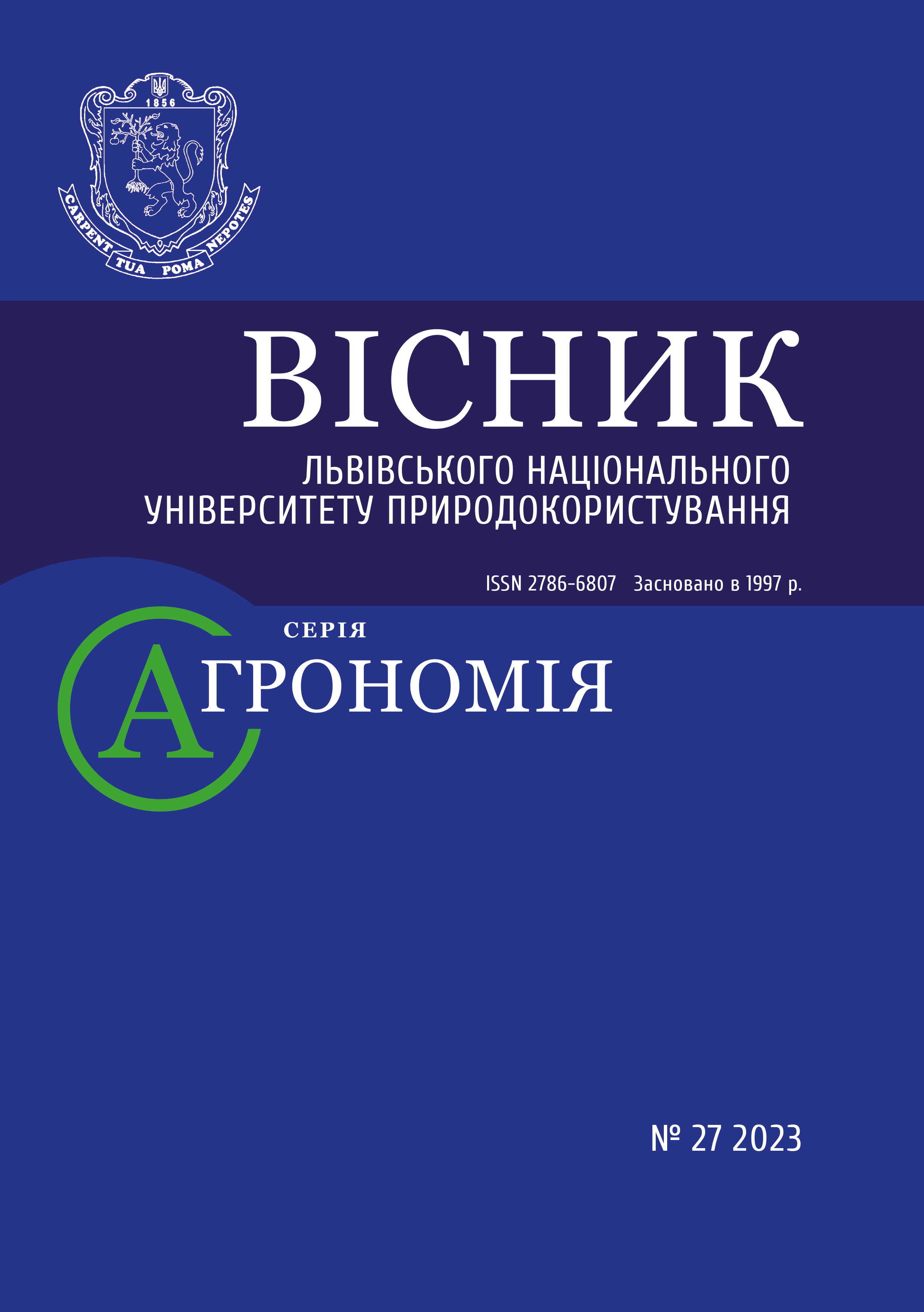ФОРМУВАННЯ ПРОДУКТИВНОСТІ СОЇ (GLYCINE MAX (L.)) НА ДЕРНОВО-ПІДЗОЛИСТОМУ ҐРУНТІ ЗА РІЗНИХ ДОЗ УДОБРЕННЯ І МЕЛІОРАНТІВ
DOI:
https://doi.org/10.31734/agronomy2023.27.140Ключові слова:
соя, структура урожаю, продуктивність, меліоранти, дерново-підзолистий грунт, добриваАнотація
Соя займає провідне місце у світовому землеробстві. Серед низки агротехнічних заходів, що забезпечують реалізацію потенційних можливостей сортів важливе місце займає система удобрення. Враховуючи розширення площ її вирощування у зоні Західного Полісся проведено дослідження щодо формування індивідуальних показників продуктивності рослин сої як інтегрального показника дії різних доз добрив і меліорантів на дерново-підзолистому ґрунті. Методи дослідження: польовий, біометричний, статистичний. Дослідження проведені у стаціонарному досліді. Встановлено, що застосування добрив на фоні хімічних меліорантів стабілізує інтервал висоти рослин за коефіцієнта варіації V<5%. Виживання рослин у середньому склало 80,7–80,9% у варіантах N55P20К50 і N65P50K75 на фоні 1,0 Нг та N45P60K60 на фоні 1,5 Нг CaMg(CO3)2, що більше контролю на 6,5–9,0%. Удобрення на фоні меліорантів сприяло підвищенню індивідуальної продуктивності рослин, найвищою вона була у варіанті N65P50K75 + S40 + мікродобриво (двічі) на фоні 1,0 дози Нг СaMg(CO3)2: кількість бобів 13,7 шт., кількість зерен на рослині 30,1 шт., маса 1000 зерен 166,6 г, маса зерна з рослини 5,02 г. Однак, дані величини не були значущими при р≤0,05 порівняно з дозою N55P20K50 за інших однакових умов. Регуляція показників структури сої за рахунок удобрення на фоні меліорантів зумовила вищу насіннєву продуктивність культури. У середньому за 2021-2022 р. найвищу 2,48 і 2,60 т/га урожайність насіння забезпечили дози N55P20К50 і N65P50K75 із додаванням S40 + мікродобриво на фоні 1,0 Нг дози CaMg(CO3)2. Встановлено, що одностороннє внесення азотних добрив у дозі N55 із додаванням S40 + мікродобриво(двічі) на фоні 1,0 дози CaMg(CO3)2 підвищило урожайність на 58,9% до контролю і на 15,6% до фону, але значно поступалася варіантам повного мінерального живлення.
Посилання
Alieksieiev O. O. Influence of environmental factors on the development and productivity of leguminous rhizobial symbiosis. Agriculture and forestry. 2016. No 4. P. 187–196.
Barabolia O. V., Naidion M. Yu., Kononenko S. M., Korovnichenko S. H. Effect of mineral nutrition on productivity of soybeans. Bulletin of Poltava State Agrarian Academy. 2020. No 4. P. 35–44. DOI: doi.org/10.31210/visnyk2020.04.04.
Gan Yinbo, Mark B. Peoples, Benjavan Rerkasem, The effect of N fertilizer strategy on N2 fixation, growth and yield of vegetable soybean. Field Crops Research. 1997. Vol. 51. Iss. 3. P. 221–229. DOI: https://doi.org/10.1016/S0378-4290(96)03464-8.
Hospodarenko H. M. Agro-economic prospects of using nitrogen fertilizers for field crops. Bulletin of Uman National University of Horticulture. 2021. Iss. 99. Part 1. P. 6–16. DOI: 10.31395/2415-8240-2021-99-1-6-16.
Kahraman A. Changes in the mineral composition in soybeans (Glycine max L.) depending on cultivation factors. J. Elem. 2022. No 27 (3). Р. 727–738. DOI: 10.5601/jelem.2021.26.4.2196.
Kaminskyi V. F., Mosiondz N. P. Formation of soybean productivity depending on agrotechnical measures in the conditions of the Northern Forest Steppe of Ukraine. Feeds and Feed Production. 2010. No 67. P. 45–50.
Lykhochvor V. V., Petrychenko V. F. Physiological role of nutrients and fertilization systems of field crops. Lviv, 2021. 288 p.
Moldovan V. H., Moldovan Zh. A., Sobchuk S. I., Halysh O. I. Formation of the elements of the soybean crop structure depending on the methods of main tillage, fertilization and pre-sowing seed treatment. Feeds and Feed Production. 2017. No 84. P. 114–119.
Nurida Neneng Laela, Rachman Achmad. Amelioration of Acid Upland to Increase Soil Productivity and Soybean Yield. AGRIVITA, Journal of Agricultural Science, [S.l.]. 2020. V. 42, No 2. Р. 350–359. DOI: https://doi.org/10.17503/agrivita.v42i2.1790.
Ohurtsov Ye. M., Mikhieiev V. h., Belinskyi Yu. V., Klymenko I. V. Adaptive soybean cultivation technology in the Eastern Forest Steppe of Ukraine. Bulletin of Kharkiv National Agricultural University named V. V. Dokuchayev. Series: Crop growing, selection and seed production, fruit and vegetable growing. 2018. No 1. P. 173–189.
Petrychenko V. F., Lykhochvor V. V., Ivaniuk S. V. Soybean: monograph. Vinnytsia: Dilo, 2016. 400 p.
Repilevskyi E. V. Economic efficiency of soybean production in the market economy conditions. Bulletin of Poltava State Agrarian Academy. Series: Economic Sciences. 2011. Iss. 2. Vol. 2. P. 215–220.
Soybean: monograph / ed. V. V. Kyrychenko. Kharkiv, 2016. 400 p.
Statistical information: agriculture, forestry, fisheries. URL: https://www.ukrstat.gov.ua/operativ/operativ2019/sg/ppsgk/arh_ppsgk_u.html/ (Accessed June 8, 2023).
Stryzhak A. M. Current conditions and prospects for the development of soybean seed production in Ukraine. Taurida Scientific Herald. 2018. No 99. P. 141–147.
Vasylenko M., Dushko P. Nutrient regime of gray forest soil under different soybean fertilization systems. Bulletin of Agricultural Science. 2019. No 97 (4). P. 11–15.


